Art Theory That Does Not Focus on Historical Context
Formalism fine art initially emerged as a response to the Post-Impressionism motion during the late 1800s. Information technology was viewed as a critical approach to the manner that art was being viewed and produced, as different values regarding aesthetic quality began to develop. This shift in deciphering what fine art stood for was attributed to a alter in thinking, every bit artists practicing inside this movement all attempted to answer the bones question of what fine art was. Thus, Formalistic theory focused on analyzing and comparison various forms and styles of art.
Tabular array of Contents
- 1 What Is Formalism?
- 2 Formalism in Fine art
- ii.1 L 'Art Cascade L 'Art (Fine art for Art's Sake)
- ii.2 The Bloomsbury Group
- 2.three Clement Greenberg's Advocacy of Formalism
- 3 An Appropriate Formalism Definition
- 3.one Central Elements and Characteristics of Formalism
- iv
- 5 Zombie Formalism
- half-dozen The Most Famous Formalism Art Pieces and Their Artists
- vi.i Nocturne in Blackness and Golden: The Falling Rocket (1875) by James McNeill Whistler
- 6.2 The Rope Dancer Accompanies Herself with Her Shadows (1916) by Man Ray
- 6.three Composition with Large Red Airplane, Yellow, Black, Grey, and Blue (1921) by Piet Mondrian
- half dozen.4 Flag (1954 – 1955) past Jasper Johns
- 6.5 Soft Spoken (1969) by Josef Albers
- vi.6 2 Sides of the Aforementioned Coin (2012) by Lucien Smith
- vi.7 Formalism in Other Arts
- 6.viii Literary Formalism
- 6.9 Formalism Photography
- 7 The Decline and Legacy of Formalism
- 8 Oft Asked Questions
- 8.i What Is Formalism?
- 8.2 What Is Zombie Formalism?
What Is Formalism?
Throughout fine art history, artworks have traditionally been analyzed by their form and the structural elements that have been discernible to the naked middle. At certain times, additional meaning has been attributed to works of fine art based on their bailiwick matters and overall intention, besides as their price value. As the concept of what art stood for developed and unlike movements emerged, paintings and sculptures began to be evaluated on the distinct characteristics that informed each move as opposed to conventional methods.
When Formalism arose in the tardily nineteenth century, the movement reiterated the importance of basing an understanding of art through its conventional elements only, which included form and style. Formalism in fine art placed focus on a diversity of elements that were seen equally important when it came to appreciating an artwork, such equally colour, line, shape, and texture.
This led to the context of artworks being diminished and seen equally a secondary characteristic, as the physical elements used to construct the artwork were emphasized.
The road to truly agreement the concept of Formalism art is both philosophical and extremely revolutionary. The theories of Aristotle, Plato, and Immanuel Kant have worked to inform the abstract notions behind Ceremonial, while experimentations within the avant-garde accept led the way for the development of socially engaging and conceptual art.
The combination of these ideals has fundamentally encouraged the germination of the type of fine art that attempts to answer the most basic question: what is fine art?
Equally the art world has continued to flourish, finding an answer to this question has been challenging. Through the presence of every new art movement, a universal way to determine the quality of an artwork has attempted to be created. Formalism'due south approach to deciphering artwork helped introduce the concepts of science and criticism into the art world, which solely focused on the level of skill present within a work. While many other critiques exist today, the concepts introduced by Formalism fine art are still in use today.
Ceremonial in Fine art
During the late 1800s, Formalism emerged equally a critical approach in response to the Mail-Impressionism movement that was dominating art civilisation. This shift was mainly informed past philosophy and the statements of artists at the time, who started to view fine art equally merely a sheet covered in colors and arranged in specific patterns. This thought helped to build the initial foundation of what Formalism art stood for, despite information technology existence considered a quite narrow-minded concept to begin with.
The major focus of Formalism was the visual and aesthetic quality of an artwork.
This was determined by the bones aspects of artmaking and through assessing the work's visual and fabric aspects. In painting, also as other art mediums, Ceremonial referred to the agreement of basic elements like color, shape, line, and texture. These perceptual aspects were deemed to be more important than the actual content, meaning, or context of the work, as its value lay in the relationships between the different compositional elements.
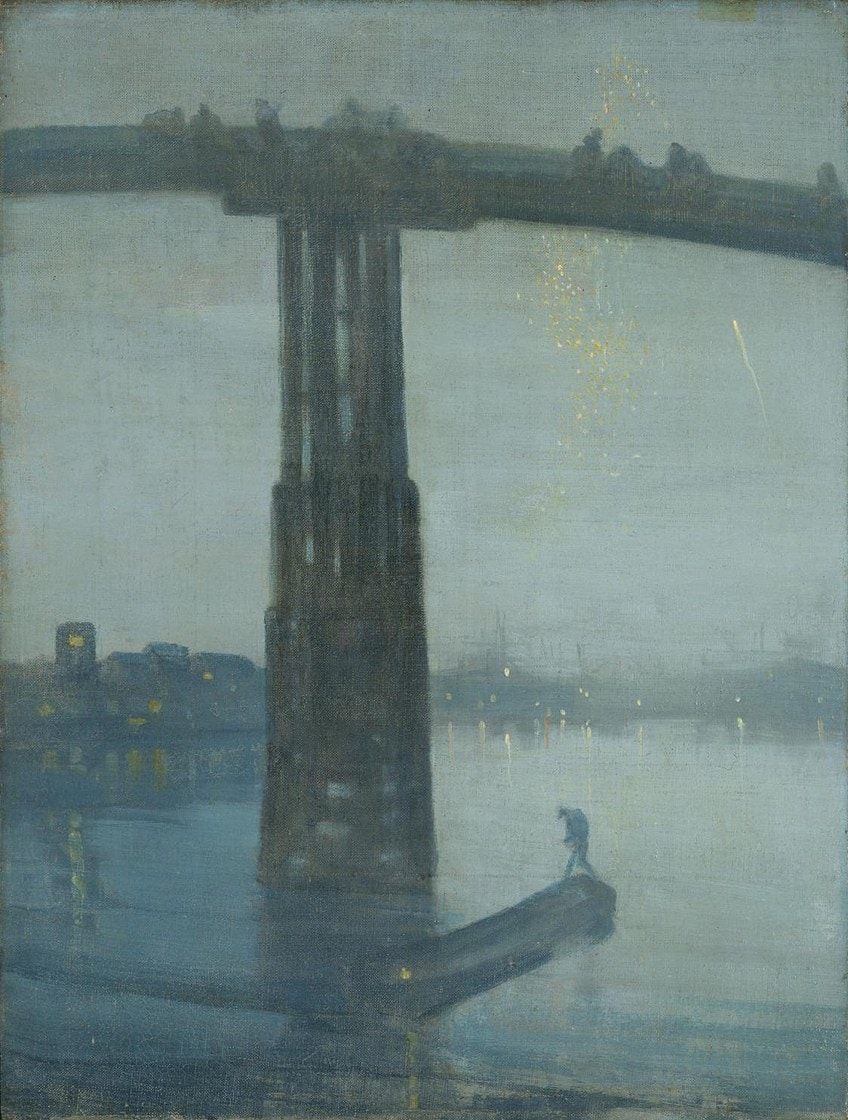 Nocturne in Blue and Gold: Onetime Battersea Bridge (c. 1872-1875) by James McNeill Whistler ; James McNeill Whistler, Public domain, via Wikimedia Commons
Nocturne in Blue and Gold: Onetime Battersea Bridge (c. 1872-1875) by James McNeill Whistler ; James McNeill Whistler, Public domain, via Wikimedia Commons
Formalism essentially proposed the thought that everything needed to comprehend an artwork was nowadays within the bodily work of fine art itself. Although Formalistic theory mainly indicated a mode of interpreting fine art rather than really making art, influential artists like Jackson Pollock and Paul Cézanne were associated with the approach, which demonstrated its great influence.
As the schoolhouse of idea that was Formalism began to proceeds traction, it was viewed as both an art movement and a facet of art critique and appreciation.
The rise of Formalism was seen as inseparable from the rise of abstracted painting during the xixth century, every bit both movements became intertwined due to their like ideas. Formalism and Abstraction focused on the significance of compositional elements like shape, texture, and color human relationship, which rose to prominence in the viewer's recognition of art. The later on emergence of Cubism in the early 20thursday century helped Formalism proceed to reach even higher levels of fame than information technology already had.
L 'Fine art Pour L 'Art (Art for Art'southward Sake)
The initial formation of Formalism art was advised past the philosophy of l'fine art cascade l'art, which translated to "art for fine art's sake". While this phrase was first used by the French philosopher Victor Cousin during the early 1800s, French novelist Théopile Gautier'southward 1835 novel captured the earliest declaration of the idea that art was valuable equally art.
By the middle of the 19th century, several literary and visual artists were influenced past the idea that art existed just for its own sake and attempted to pursue this notion in their works.
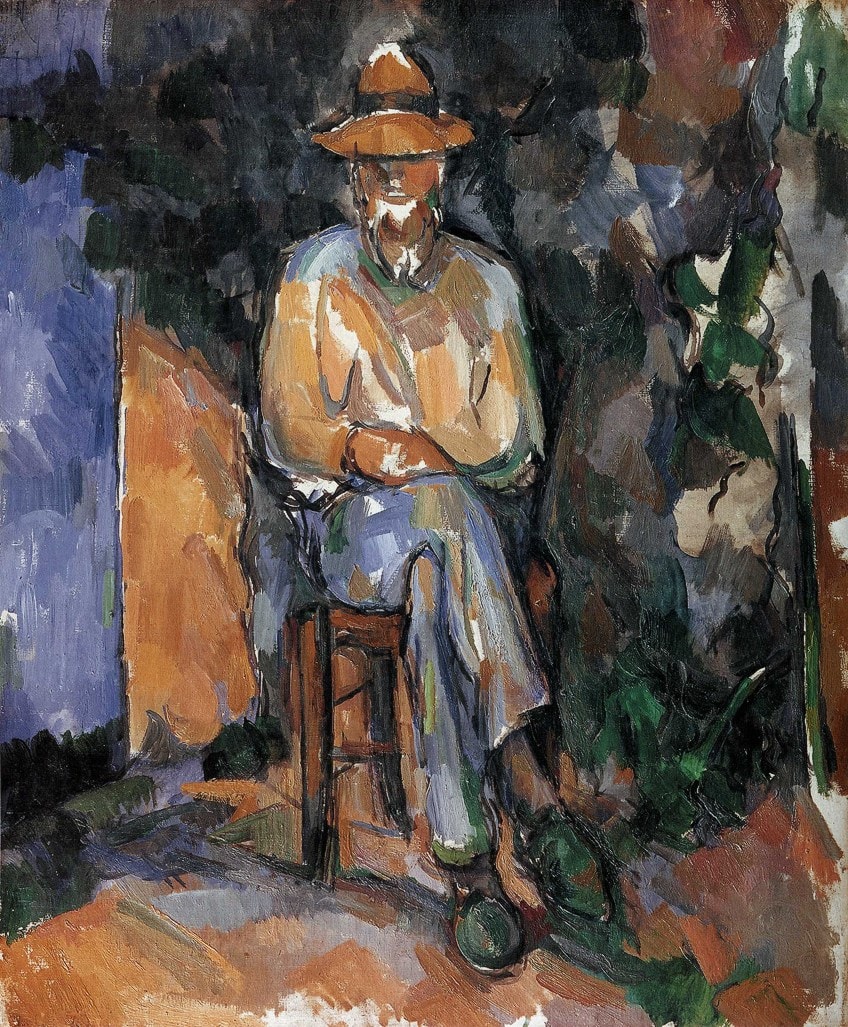 Le Jardinier Vallier (The Gardener Vallier) (1906) past Paul Cézanne;Paul Cézanne, Public domain, via Wikimedia Commons
Le Jardinier Vallier (The Gardener Vallier) (1906) past Paul Cézanne;Paul Cézanne, Public domain, via Wikimedia Commons
As Formalistic theory viewed the value of fine art through specific aspects, this doctrine of artistic principles at the time believed artworks should not serve whatsoever social or moral purpose. Art adhering to this ideal needed no purpose other than its inherent dazzler, as the value of an artwork was thought to be found mainly in its structural elements.
As this idea was closely related to the Formalistic view of art, all of the elements seen outside of the principal aspects were viewed equally having no integral purpose to the meaning of the work.
Seen as possibly one of the about well-known lines in all of fine art history, "art for art'southward sake" truly epitomized the Formalist way of thinking within fine art. As all artworks make use of the same basic elements, Formalistic theory emphasized the creation of a ground for agreement fine art in general, no affair its style or context. This theory of understanding allowed fine art to be seen as an independent domain of human creation, which took the pressure off of artists to come up with an explanation to their works based on any set standards.
The Bloomsbury Group
Clive Bell and Roger Fry, who were both members of the groundbreaking Bloomsbury group, established and expanded the concept of Formalism in the early 20thursday century. Every bit an artist, Fry was virtually notable for his involvement with developing Formalistic theory. One of his pioneering artworks, Art (1914), demonstrated the theory of "significant form", every bit Fry went on to ask what common qualities were shared by all types of artworks that provoked one's artful emotions.
 River with Poplars (1912) by Roger Fry, which was inspired by his involvement in the works of Paul Cézanne; The original uploader was Cactus.man at English Wikipedia., Public domain, via Wikimedia Commons
River with Poplars (1912) by Roger Fry, which was inspired by his involvement in the works of Paul Cézanne; The original uploader was Cactus.man at English Wikipedia., Public domain, via Wikimedia Commons
When considering the ideals of Formalism, the Bloomsbury group stated that the only elements in an artwork that was capable of stirring our emotions were related to form. Artists, no matter the movement they came from, were all thought to produce an artwork that related to the concept of Formalism at i time or some other, as their artistic use of lines and colors helped build onto Formalistic theory.
Clement Greenberg's Advancement of Formalism
During the middle of the 20thursday century, iconic American critic Clement Greenberg defined the Formalism art arroyo through its unequaled levels of detail and rigor. This led to him being seen as one of the most well-known supporters of Ceremonial in the modern era, with the term generally being associated with him equally fourth dimension went on. Additionally, the artists that Greenberg praised, such every bit the Abstract Expressionists, were too associated with the concepts of Formalism due to the elements seen in the artworks that they produced.
According to Greenberg, Formalism encompassed everything that was intellectually refined and progressive within fine art, equally opposed to what was seen as ostentatious, tasteless, or vulgar.
Greenberg believed that the purpose of avant-garde art, the likes of those that were produced during the Formalism movement, was to provide surreptitious analyses of the formal limits of artistic expression itself. This understated form of self-reflexivity was said to only exist fabricated possible through the daring compositional elements made popular by Ceremonial in art.
Describing Ceremonial in his 1960 essay, "Modernist Painting", Greenberg advocated for the detachment of context and subject thing from the form of art, every bit he believed that abstracted artworks exemplified the truest expressions of fine art.
His opinion on Ceremonial remained resolute for some fourth dimension, with his influence only beginning to fade during the early 1970s. This was led by his followers who started to rebel confronting the concepts of Formalism, which led to Greenberg's theories existence criticized for existence as well dogmatic in the mod world of art.
An Appropriate Ceremonial Definition
Formalism existed as an artistic concept that attempted to notice out what art as an idea substantially stood for. Ceremonial in fine art sought to understand how one could decide an ordinary piece of work of fine art from a masterpiece, which led to a groovy focus being placed on the primary elements within artmaking. Thus, the term "Formalism" has been used to describe a technique of art critique to examine works of fine art, with this method being seen as one of the oldest methods e'er used to evaluate art.
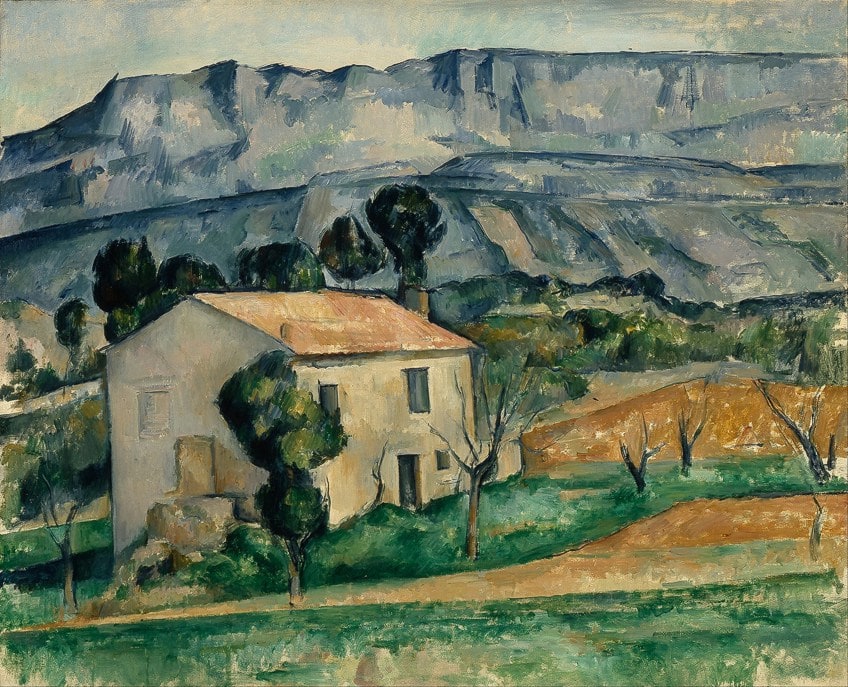 Paul Cézanne's Maison devant la Sainte-Victoire près de Gardanne (" Business firm in Provence") (1886-1890) was ane of only two mod works included in Clive Bell's Art (1914);Paul Cézanne, Public domain, via Wikimedia Commons
Paul Cézanne's Maison devant la Sainte-Victoire près de Gardanne (" Business firm in Provence") (1886-1890) was ane of only two mod works included in Clive Bell's Art (1914);Paul Cézanne, Public domain, via Wikimedia Commons
The approach that fabricated upwards Formalism helped form the footing of what is known as art criticism today and has been seen as 1 of the reasons that artists aspired to larn more near and improve upon their natural abilities. Farther emphasized by its proper name, Ceremonial placed its sole focus on the compositional elements of an artwork.
Equally no attention was given to the content and context of the work, as well as the artist's intended significant, the Formalism definition branded it every bit a movement that only valued the formal aspects of an art piece.
Key Elements and Characteristics of Formalism
Based on the Ceremonial definition, the movement'southward approach stated that art could only exist truly analyzed afterward because the elements of class and style inside a work. As the content and context of artworks were made into secondary characteristics in terms of their importance, Formal fine art focused on the level of skill that was displayed by an artist.
Thus, the fundamental characteristics of Formalism that proved to be essential in evaluating an artwork were the veracity of the materials used, equally well as its medium specificity and flatness.
Truth to Materials
A central principle of Formalism in art was the emphasis that was placed on the materiality of an artwork. This was known via the term "truth to materials", which went on to become a key concept within 20th-century art in general. The materials used to create art were all thought to accept their own individual qualities, which were further highlighted when combined together. This concept of the importance placed on the blazon of materials used dated back to the 19thursday century, which helped inform the emergence of Formalism itself.
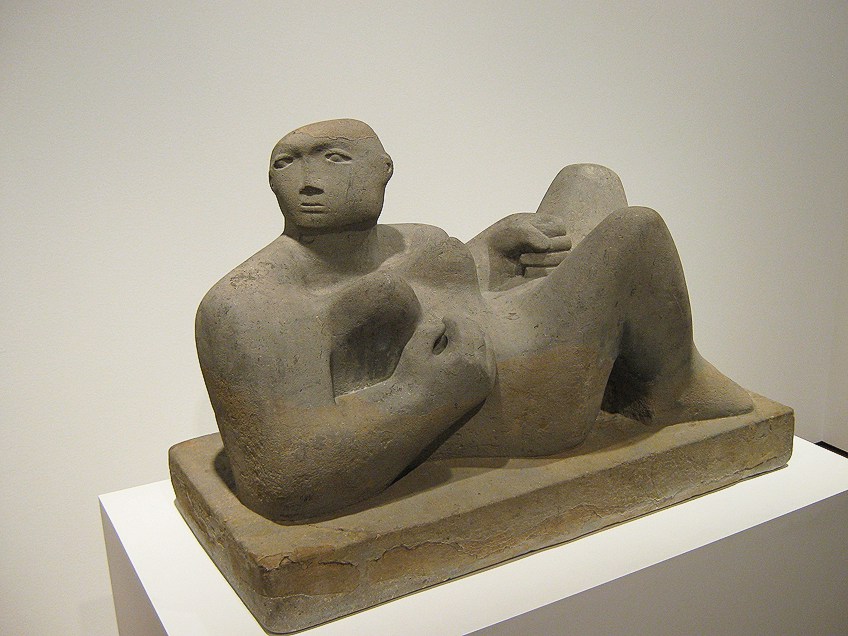 Reclining Woman (1930) by Henry Moore. In 1934, British sculptor Henry Moore stated the following about the concept of truth to materials: "Every material has its ain private qualities … Stone, for example, is difficult and full-bodied and should not exist falsified to look like soft flesh … Information technology should keep its hard tense stoniness."; Gbuchana at English Wikipedia, CC0, via Wikimedia Commons
Reclining Woman (1930) by Henry Moore. In 1934, British sculptor Henry Moore stated the following about the concept of truth to materials: "Every material has its ain private qualities … Stone, for example, is difficult and full-bodied and should not exist falsified to look like soft flesh … Information technology should keep its hard tense stoniness."; Gbuchana at English Wikipedia, CC0, via Wikimedia Commons
Inside Formal art pieces, materials were traditionally used that went on to elevate the elements of line, color, form, and shape. In doing then, the characteristic of "truth to materials" helped to focus the attending onto the aspects that were considered to exist of the utmost importance within Formalism artworks. While the truth that was paid to the type of materials used helped in the development of Formalism, this concept as well gave mode to the ascent of the Minimalism movement afterward Abstract Expressionism. When art critic Cloudless Greenberg arrived on the scene, he introduced his renowned concept of medium specificity into art. Also known every bit medium purity, Greenberg expanded on a notion of the movement from a wider Formalistic theory, which he went on to detail in his 1960 essay titled Modernism. While developing the theory of Formalism, Greenberg dedicated the principal and formal elements seen within Formal art pieces, as well as the distinctiveness that was paid to the mediums used. Additionally, Greenberg spoke almost the aspect of flatness that could be seen within Formal art pieces, which was essentially linked to the concept of medium specificity. He viewed flatness equally a defining chemical element in Formalist painting, as it was considered to be a unique and exclusive medium to pictorial art. Medium specificity and flatness were seen as interrelated concepts, as they were both eschewed any attempts at suggesting iii-dimensionality or sculptural form in artworks, which was exactly what Formalism stood against. Ceremonial ruled the modern art scene until the 1960s when information technology arrived at its acme and began to exist challenged past the ideals of Postmodernism. Still, in 2014, Formalism entered the fine art world again after artist and critic Walter Robinson came up with the term "Zombie Formalism" to describe a new trend in abstract painting that was emerging. In an economic sense, Zombie Formalism was possibly i of the biggest movements in the past decade, equally it went on to transform the art market place and what it meant to be an inexperienced creative person. The name of the move was first presented in Robinson's 2014 slice, Flipping and the Rising of Zombie Formalism. This artwork addressed the trendy behavior of art collectors at the time, who were snapping up sure types of paintings at low prices before flipping these works for a college cost at auctions. Beginning in 2011, the art market demonstrated a voracious appetite for a specific blazon of painting that paralleled the theme of undead movie house, which gave ascent to the development of Zombie Formalism. The types of artworks favored during the Zombie Ceremonial era appeared to be quite ubiquitous, as the majority of them looked the same. Zombie Formalism emerged as a make of abstraction through the types of artworks that were made famous. Despite about of the works actualization to be indistinguishable from one some other, they tended to waver between either resembling a haphazard semblance of a drawing or a careful Minimalistic approach to a type of Color Field painting. The method of creation used by artists inside Zombie Formalism echoed the original Abstract Expressionist principles that were championed past Greenberg. What made this style unlike was that artists did not accelerate on the principles of Ceremonial simply instead incorporated exaggerated and unnecessary theatrics into their works. This stagnant creation explained the improver of "zombie" to the proper noun, as the move was revived in the modern era without whatsoever attempt to further it, much similar the inactivity associated with zombies. The social media platform of Instagram helped Zombie Formalism abound in popularity, as it often led to certain paintings and artworks going viral. This element of instant gratification made collectors want to buy the famous slice in order to resell it then that they were able to stay relevant in the fine art globe likewise. With that being said, the blazon of artworks to reach such dizzying levels of fame often appealed to those who had almost no artistic groundwork or knowledge, as these works were seen equally offensive to the standard of fine art by critics. This rise in Zombie Formalism was led by the sudden surge of wealth disparity in the economy that was not seen since the likes of the Gilt Historic period. All of a sudden, new and profit-hungry individuals whose power was essentially driven by their wealth attempted to enter into the art marketplace and chose to follow the near relevant trend at that time. These buyers were referred to as "COINs", which meant "Collectors Just in Proper name", and were fabricated up predominately of stoke brokers who unexpectedly entered the art marketplace. Through the financial backing of society's wealthiest individuals, Zombie Formalism saw the rising in the value of paintings reach more than 3000 percent above their price thanks to "Zombie Collectors". By the cease of 2015, the need for the Zombie aesthetic had completely faltered, with the majority of the artworks plummeting in price and becoming completely unsellable. As the ascent of this motility was dictated by those who were clueless every bit to what art was, it seemed fitting that this group would mark the menstruum's refuse. Every bit the Formalism move proved to exist a notable time within art history, several artists experimented with its ethics in their artworks. This led to some incredibly well-known artworks being produced, past equally important artists. Below, nosotros volition exist taking a wait at some of the iconic Ceremonial art pieces to come from the movement. Painted by British artist James McNeill Whistler in 1875, Nocturne in Black and Gilt: The Falling Rocket is widely considered to be a significant artwork from the Formalism era. Whistler believed that all art should exist independent of whatsoever nonsensical aspects and should stand solitary, so every bit to truly emphasize the of import elements. Seen equally a leading figure within Formalism, the Aesthetic motility, and Tonalism, his "nocturne" artworks became influential examples of a Formalist approach. Nocturne in Black and Gilt: The Falling Rocket depicted a dark-time firework display that was taking place at the Cremorne Gardens in London. Existing every bit the last artwork in his "nocturne" serial, this painting presented a lively explosion as opposed to a concrete image. Past conveying the furnishings of the fireworks over the river, Whistler captured the great sense of excitement and commemoration that could be felt as the rocket flare-up into a myriad of colors. Every bit the darkness was lit up, a few figures along the shore could be seen in the foreground. Whistler painted Nocturne in Black and Gold: The Falling Rocket in a very loose style with sweeping brushstrokes. The gloomy blues and greens, which made up the predominant color palette, were interrupted by tiny bursts of bright color. Whistler described his colors as adding to the idealistic and pensive mood of the painting, every bit no clear narrative was made known. Every bit this artwork embraced ethics of fine art for art's sake, it was ill-received when it was first exhibited, as it was idea to be an incredibly reckless and devil-may-care painting. An extremely famous artist who emerged during the Modernism era was American sculptor, painter, and lensman, Man Ray. As an creative person who was well-known in both America and Europe, he was considered to be a significant figure in representing the interaction between the artists of these countries, peculiarly when the Formalism motility entered America. Ray stated that the creative force and expressiveness of a painting resided in the fabric, color, and texture in a work, all of which were able to come together on the flat plane of the canvass. Within The Rope Dancer Accompanies Herself with Her Shadows, a vaudeville tightrope dancer can be seen. Portrayed with a petite grey and white effigy, the dancer can exist seen at the top of the painting on peak of the big abstracted planes of bright colors. These colors were said to signal the shadows of her svelte movements, but they went on to resemble a type of collage instead as they overlapped one some other. This painting came to be through several initial experiments and by Ray's chance finding of the designs his cutouts made. Exhibited at the Museum of Modernistic Art in New York today, The Rope Dancer Accompanies Herself with Her Shadows demonstrated the abstract representations of the dancer's movements. These went on to control the entire canvas, which placed the emphasis on the primary elements. In doing so, Ray was able to make his formal effects the main focus within this work, which was what the Formalism motility stood for. Dutch artist Piet Mondrian was an of import member of the European fine art scene, as he was one of the founders of the iconic De Stijl move. He was known for his portrayals of the world through vertical and horizontal lines, with this singular vision demonstrating his preference for abstraction. Composition with Large Crimson Plane, Yellow, Black, Grey, and Blue, painted in 1921, exists as an important example of Formalism art. The entire focus of the piece of work is placed on the lines used to create the various boxes of primary colors. By offsetting the multiple boxes of colour confronting a properties of black and white, Mondrian went on to create what before long became known every bit his signature style. The level of abstraction seen within this work is noticeable, as Mondrian just created a sail full of lines and colors. The thick, black horizontal and vertical lines worked to mark out the outlines of the various boxes, which effectively kept the colors separate from one some other. This limerick demonstrated a type of abstract art that differed profoundly from Cubism and Futurism. The simplification of the pictorial elements that tin be seen within Composition with Big Red Aeroplane, Yellow, Black, Gray, and Blueish became essential aspects in Mondrian's other artworks. Greenberg acknowledged Mondrian's work equally an important example of Formalism, equally the strict geometry present in his paintings helped imitate the varied rhythm of modern life. This painting of Mondrian, along with several others of his, went on to influence subsequent generations of Formalist artists and artworks. American painter, sculptor, and printmaker Jasper Johns went on to affect nearly all artistic movements from the 1950s upward until the present twenty-four hour period. His playful and mysterious artworks were known for the style in which they questioned how the world was viewed and interpreted. Flag, which was painted on iii panels between 1954 and 1955, exists as Johns' kickoff major artwork that broke away from the Abstruse Expressionist fashion of the fourth dimension. Portraying the American flag, his painting was a representation of an instantly recognizable object. Made up of a collage of newspaper pieces, Flag was created over three plywood panels that were combined. The method of creation for this artwork added to its uniqueness, as the scraps of newspaper were painted over with pigment and melted wax to stay together. Johns' mode, along with this specific artwork, has frequently been thought to have paved the manner for the emergence of Pop Art through re-introducing immediately identifiable subject matter into modernistic art. Despite the elementary elements of line and color beingness present in this work, Flag presented a dilemma for Formalist critics like Greenberg. While the artwork itself maintained the aspects of Formalism, Johns' made it virtually impossible to deny the presence of an obvious bailiwick affair. The American flag jumps out at audiences the moment they view this work, as this symbol was designed to stand out through its Formalist terms. Although Greenberg and other critics rejected this work, Johns' followers did not, which led to its fame. Some other well-known American painter and sculptor was Josef Albers, who was instrumental in bringing the notions of European Modernism over to the Usa. Located at the Metropolitan Museum of Modern Art in New York is his artwork, Soft Spoken, which he painted in 1969. Committing to brainchild in his early works, Albers went on to experiment with a variety of colour juxtapositions in a scientific way, which created distinctly inflected forms of pictorial space. In Soft Spoken, four squares are depicted in teal bluish, light green, nighttime green, and dark purple. Based on the lodge of the to a higher place colors, the squares take been arranged in diminishing sizes and accept been placed quite low down on the canvass in an manifestly asymmetrical way. This painting formed part of Albers' Homage to the Square serial which he began in 1949, with Soft Spoken demonstrating his connected dedication to the formal investigation of color through the addition of a fourth square. The four variations of blue seen within Soft Spoken implied Albers' consistent repetition of grade and fragile colour juxtaposition, which adhered to the notions of Formalism. One of the most striking aspects of his work, which existed as an experimental variation of truthful Formalism, was the idea that his formal experimentation with color and shape could have a moral and culturally liberal value. An artist to come out of the Zombie Formalism era was Lucien Smith, who created Two Sides of the Same Coin in 2012. This artwork exemplified the trend of contemporary Formalism that was known as the Zombie period, every bit it was an artwork whose value catapulted in cost betwixt art collectors and bidders. Resembling rain or mist from a distance, Smith spray-painted black paint onto a bare canvas to create this piece of work. Upwardly close, the dots appear to be splattered and are viewed as pocket-size and private explosions on the canvas. As the painting process for Two Sides of the Aforementioned Coin was thought to be incredibly modern, it was emphasized as a truly abstracted piece of work when Smith exhibited it. Forming part of his Pelting Paintings (2011) series, this artwork was made past using fire extinguishers to spray the paint. Smith said that his process of creation was heavily inspired by the various graffiti artists in New York who also fabricated use of erstwhile fire extinguishers, which sprayed water as opposed to powder, to make compositions. Smith created Ii Sides of the Same Coin, forth with the series, while he was studying art at the Cooper Union School of Fine art. After he graduated, his works became prominent examples in the new type of art investment that had appeared onto the scene, which was Zombie Formalism. Smith's experimental artworks transfixed audiences just unfortunately, the intrigue was brusque-lived. After two years of producing works in line with Zombie Formalism, the auction prices for his works plummeted just equally quickly every bit they rose. Every bit information technology was such an influential movement, it is understandable that Formalism was non just confined to evaluating artworks. The aspects of Formalism could easily exist applied to different forms of art, which led to creatives expressing these notions in a variety of artistic genres. The concepts of Formalism were also used quite freely in both literature and photography, which were seen as additional forms of art. In literature, the aspects of Formalism emerged in the early 20th century, around the aforementioned time as Russian Formalism. In 1914, the OPOJAZ Society for the Report of Poetic Language was established in Leningrad, which emphasized a more belittling and conventional arroyo to verse and literary devices. Thus, the Formalist view in literature was more scientific and logical in nature, as the focus of the work was placed on how writing could limited linguistic communication, every bit well as how readers reacted to the dissimilar subjects of writing. Literature that relied on Formalistic theory proved to exist successful no matter the cultural context and considering of this, was believed to be able to stand up the exam of time in an ever-changing world. The intent of literary Formalism was to focus on the distinctive features and devices of literature that were unusual within creative writing. Photographs that displayed a naturalistic approach within their compositions were idea to embody the concepts of Ceremonial. Equally the art grade of photography developed, photographers became a type of visual designer whenever a specific frame was captured. This was because photographers were able to select the field of study matter that they wished to be nowadays in the scene so that the desired image was created. Formalism photography, which was sometimes seen as a form of journalism, made utilize of the potent conventional qualities of Formalism within the scenes that were captured. By juxtaposing compelling subject matter with the elements of lines, color, and textures, photographers were able to produce captivating images which demonstrated a strong influence of Formalism. Past the 1960s, the influence of Formalism began to diminish. Other movements that proved to be damaging to the methods of Formalism emerged as commanding forces, such as Popular Fine art, Minimalism, Neo-Dada, and Performance Art. Some artists felt that the ideals so heavily endorsed past Greenberg were limiting in the mod era, which led to the introduction of diverse artistic practices and methods that rejected the concepts of Formalism completely. Despite its pass up, it is important to call up that Formalism continued to permeate nigh all of the critical approaches to Modern Art in the 20th century. This has led to a blazon of survival of Formalism in the 21st century, every bit the move taps into such a fundamental aspect of all artistic interpretation that has started to exist seen as notable over again. The recognition of formal qualities, such equally the way lines and color piece of work together, too as the different textures and patterns of a surface, accept proven to be important in understanding art again. Today, virtually fine art historians and critics brand use of formal analyses when attempting to examine and sympathize artworks, with this type of thinking originating in the Formalism era. However, the sensation of civilization, history, and context that frames artworks today make the analyses distinctly dissimilar from those washed in the traditional Ceremonial era. This has led to the development of a stricter type of Formalism, which has started to spark interest in the different art periods of 21st-century fine art. Formalism proved to be an incredibly powerful and meaning movement within art history. Past placing accent on the formal and traditional elements that made upwardly fine art, this fashion re-focused critics and viewers on the main aspects that had been momentarily forgotten when it came to examining and understanding art. Many more artists contributed to this movement and if you take enjoyed reading upwardly on the development of the flow and its iconic artworks, we encourage you to explore further. Considered to be a critical grade of art, Formalism described the movement that analyzed artworks according to their form and structural elements that were easily recognizable. Ceremonial viewed the subject matter, context, and intended meaning to be of secondary importance within an artwork, every bit the formal elements that physically constructed the slice were the focal point. Reaching a peak in 2014, Zombie Formalism describes the resurgence of the Formalism movement in modern art. As a new type of abstract painting was developing, the term "Zombie Formalism" seemed appropriate as the artworks relied on all of the concepts of Formalism from the nineteenth century. What fabricated this reappearance of Ceremonial art so different from the original version, was that no effort was made to improve upon or further develop the initial aspects. Instead, artists merely included ridiculous theatrics and then as to capture attention.Medium Specificity and Flatness
 Plum Brandy (1877) past Édouard Manet. In Greenberg's view, modernist painting began with Edouard Manet'due south compression of space and use of a frontal light source that minimized chiaroscuro and denied the illusion of mass;
Plum Brandy (1877) past Édouard Manet. In Greenberg's view, modernist painting began with Edouard Manet'due south compression of space and use of a frontal light source that minimized chiaroscuro and denied the illusion of mass;
Édouard Manet, Public domain, via Wikimedia Commons
Zombie Ceremonial
The Nigh Famous Formalism Fine art Pieces and Their Artists
Nocturne in Black and Gold: The Falling Rocket (1875) by James McNeill Whistler
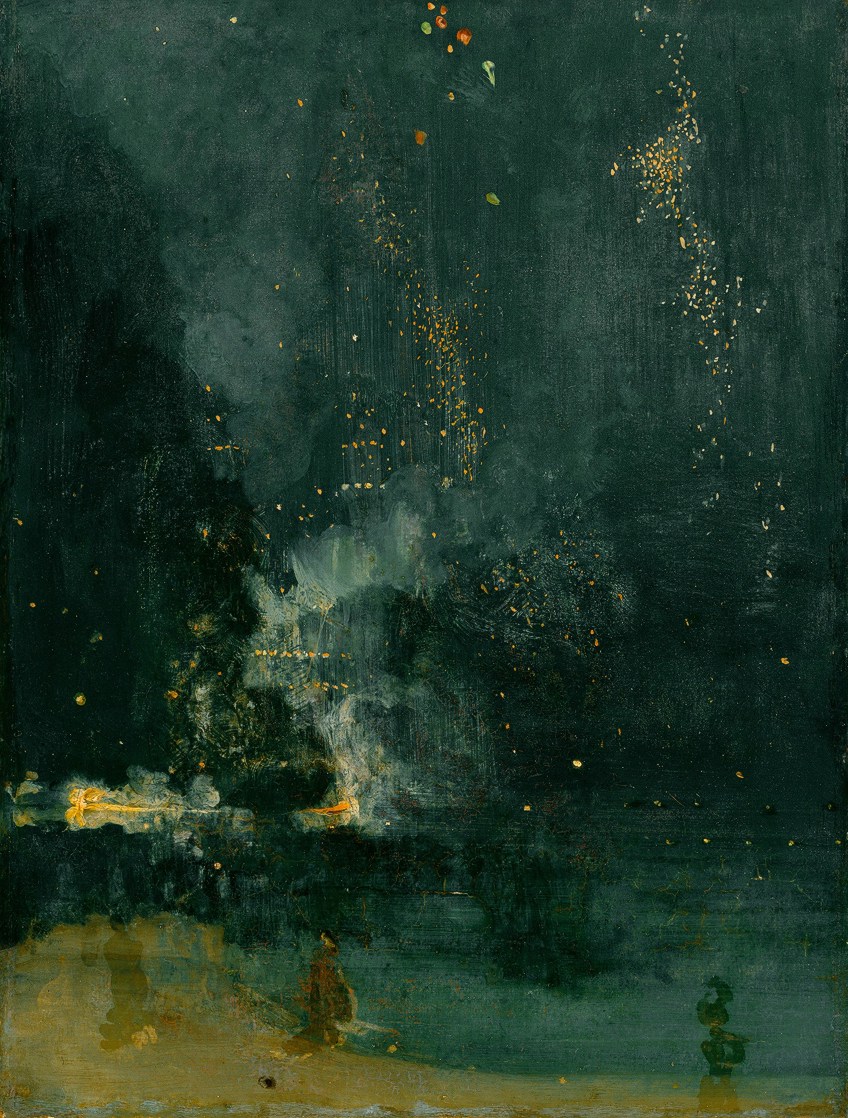 Nocturne in Black and Gilt: The Falling Rocket (1875) past James McNeill Whistler; James McNeill Whistler, Public domain, via Wikimedia Commons
Nocturne in Black and Gilt: The Falling Rocket (1875) past James McNeill Whistler; James McNeill Whistler, Public domain, via Wikimedia Commons
The Rope Dancer Accompanies Herself with Her Shadows (1916) by Homo Ray
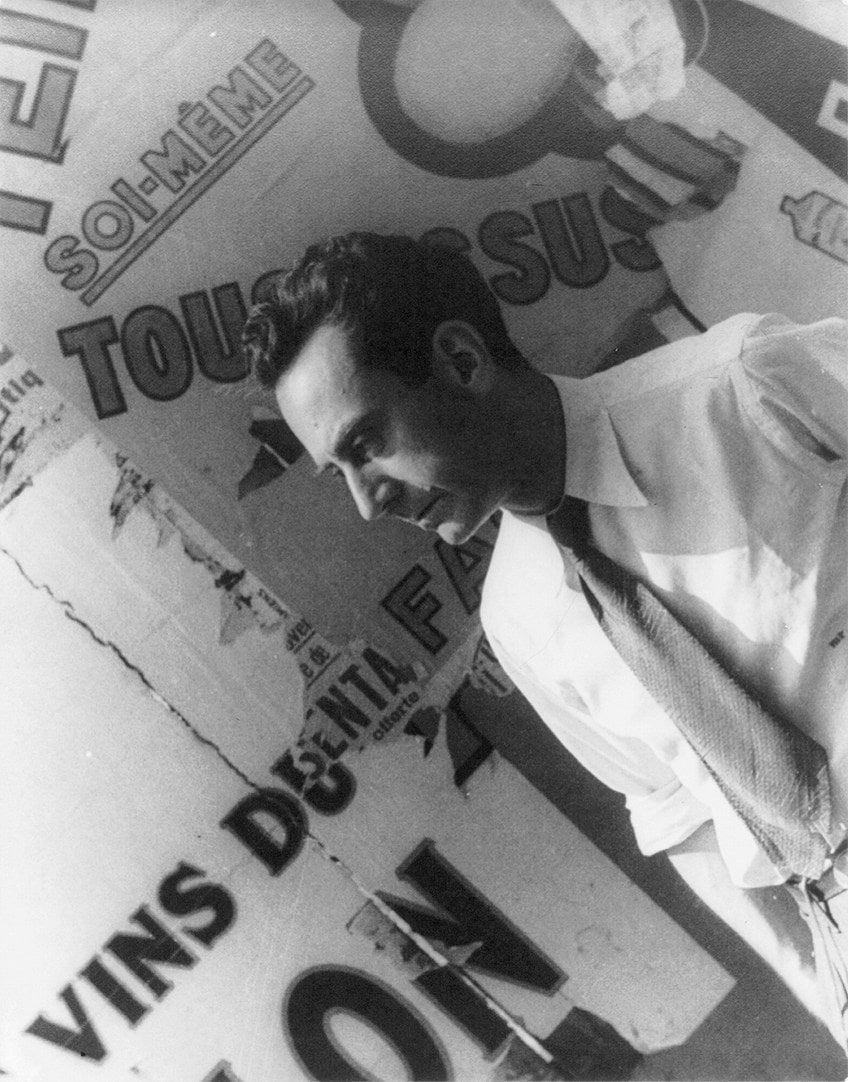 A photograph of Man Ray, 1934;Carl Van Vechten, Public domain, via Wikimedia Eatables
A photograph of Man Ray, 1934;Carl Van Vechten, Public domain, via Wikimedia Eatables
Composition with Large Red Plane, Yellow, Black, Grey, and Blue (1921) by Piet Mondrian
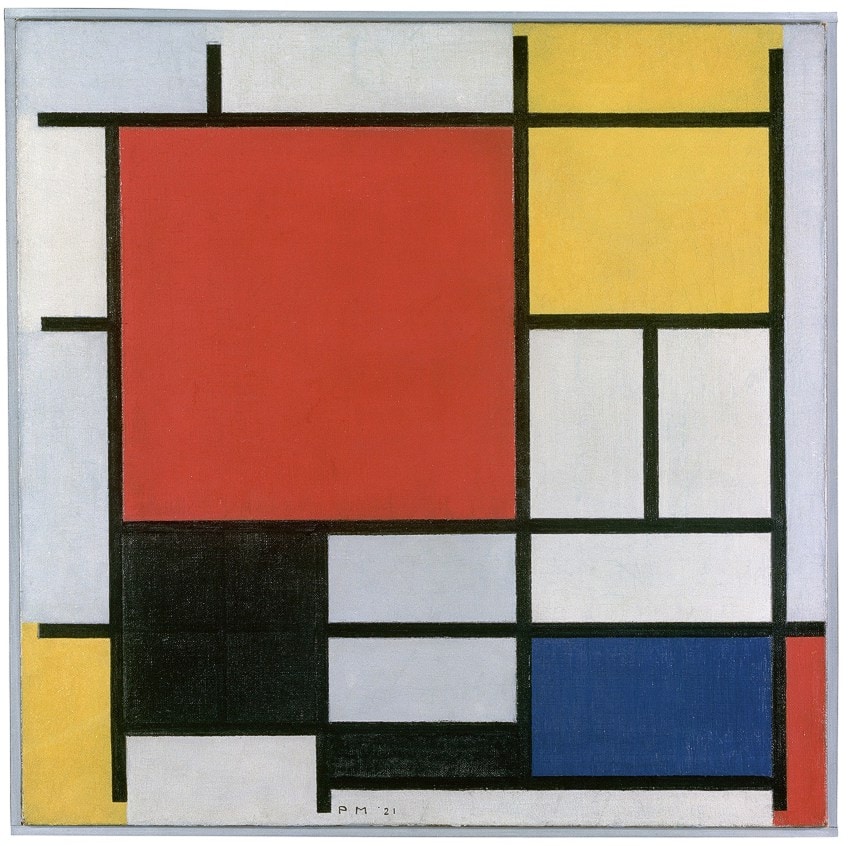 Composition with Large Red Plane, Xanthous, Blackness, Gray, and Blue (1921) by Piet Mondrian; Piet Mondrian, Public domain, via Wikimedia Commons
Composition with Large Red Plane, Xanthous, Blackness, Gray, and Blue (1921) by Piet Mondrian; Piet Mondrian, Public domain, via Wikimedia Commons
Flag (1954 – 1955) past Jasper Johns
Soft Spoken (1969) by Josef Albers
Two Sides of the Aforementioned Coin (2012) past Lucien Smith
Formalism in Other Arts
Literary Formalism
Ceremonial Photography
The Decline and Legacy of Ceremonial
Ofttimes Asked Questions
What Is Formalism?
What Is Zombie Formalism?
Source: https://artincontext.org/formalism-art/
0 Response to "Art Theory That Does Not Focus on Historical Context"
Post a Comment